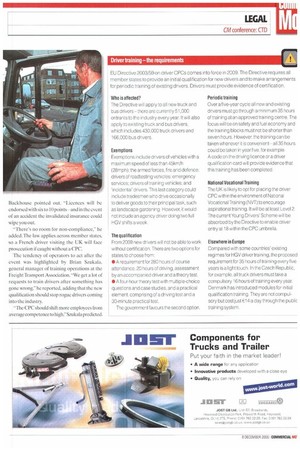Driver training — the requirements EU Directive 2003/59 on driver
Page 43

If you've noticed an error in this article please click here to report it so we can fix it.
CFCs comes into force in 2009. The Directive requires all member states to provide an initial qualification for new drivers and to make arrangements for periodic training of existing drivers. Drivers must provide evidence of certification.
Who is affected?
The Directive will apply to all new truck and bus drivers— there are currently 51,000 entrants to the industry every year. It will also apply to existing truck and bus drivers, which includes 430,000 truck drivers and 166,000 bus drivers.
Exemptions
Exemptions include drivers of vehicles with a maximum speed of less than 45km/h (28mph). the armed forces, fire and defence drivers of roadtesting vehicles emergency services; drivers of training vehicles; and 'incidental' drivers. This last category could include tradesmen who drive occasionally to deliver goods to their principal task, such as landscape gardening. However, it would not include an agency driver doing two full HGV shifts a week.
The qualification
From 2009 new drivers will not be able to work without certification. There are two options for states to choose from: • A requirement for 280 hours of course attendance, 20 hours of driving, assessment by an accompanied driver and a theory test.
• A four-hour theory test with multiple-choice questions and case studies, and a practical element. comprising of a driving test and a 30-minute practical test.
The government favours the second option. Periodic training Over a five-year cycle all new and existing drivers must go through a minimum 35 hours of training at an approved training centre. The focus will be on safety and fuel economy and the training blocks must not be shorter than seven hours. However, the training can be taken whenever it is convenient— all 35 hours could be taken in year five, for example. A code on the driving licence or a driver qualification card will provide evidence that this training has been completed.
National Vocational Training
The UK is likely to opt for placing the driver CPC within the environment of National Vocational Training (NVT) to encourage aspi rational training. It will be at least Level 2. The current Young Drivers' Scheme MI be absorbed by the Directive to enable driver entry at 18 with in the CPC umbrella.
Elsewhere in Europe
Compared with some countries' existing regimes for HGV driver training, the proposed requirement for 35 hours of training every five years is a light touch. In the Czech Republic, for example, all truck drivers must take a compulsory 16 hours of training every year. Denmark has introduced modules for initial qualification training. They are not compulsory but cost just €14 a day through the public training system,




































































































































































































